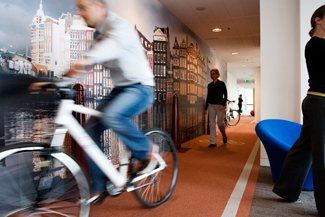Even if CNN and Fortune hadn’t repeatedly named Google as one of the best places to work, they would certainly top of a list of most envied places to work. From the outside looking in Googlers have some of the coolest jobs around, and they get to do it at a place called the Googleplex. We thought our office was cool, but come on! Google has segways, hammocks, and free food!
It’s fairly well known that amongst the many, many perks that Googlers enjoy is free food. At the Googleplex and satellite offices, the company keeps its hard working staff well fed. Sometimes too well, with bowls of M&Ms suspended from ceilings and unlimited passes at cafeteria buffets, it’s like a cruise you get paid to attend.
Recently, Google made some changes in an effort to make the environment even healthier for its employees. If they’re gaming for a healthiest places to work award too, they might win. Google recently revealed some of the changes they’re rolling out.
“We’ve used some things in some offices but haven’t implemented them across the board,” Katelin Todhunter-Gerberg told us, a senior public affairs associate for Google.
The changes are in response to surveys that Google asked its employees to take part in. They asked things like “how healthy do you feel at work?” and used that feedback to remove the free candy in one office and fill another office’s micro-kitchens with more bottled water. They’ve worked to decrease the amount of sugar-based snacks in the micro-kitchens and “provide more sustenance,” Katelin told us.
In one location, the salad bar is front and center in the cafeteria because research has shown that people tend to eat the first thing they see. To this point, desserts have been de-emphasized and placed in a less high-profile location. Desserts have also been resized, with no portion more than about three bites.
Katelin also described how Google’s chefs are following the Harvard Healthy Plate, their version of MyPlate. “Over the past year we’ve incorporated a color code system,” she said. Each food is paired with a colored card: red means you should have it sparingly (dessert), yellow means you can have it moderately (croissants), and green means you can have a lot (salad). All of this “makes it easier for employees to make improvements,” said Katelin.
 Google’s also revamping the way it looks at fitness. Katelin explained that they have gyms on site in a lot of offices, and subsidize paid gym memberships when they can’t have in-house gyms. One specific example she cited was in Mountain View where they have more bikes available for employees to ride across campus for meetings, where it can sometimes be a ten-minute ride. There are also fitness classes during the middle of the day. Employees can take Pilates, dance, Zumba, or a number of other group fitness classes. Katelin told us this helps employees make fitness part of the flow of their day, instead of one more thing to do after work.
Google’s also revamping the way it looks at fitness. Katelin explained that they have gyms on site in a lot of offices, and subsidize paid gym memberships when they can’t have in-house gyms. One specific example she cited was in Mountain View where they have more bikes available for employees to ride across campus for meetings, where it can sometimes be a ten-minute ride. There are also fitness classes during the middle of the day. Employees can take Pilates, dance, Zumba, or a number of other group fitness classes. Katelin told us this helps employees make fitness part of the flow of their day, instead of one more thing to do after work.
As opposed to the typical “come at 9, grind, and leave” mentality that most Americans put themselves through, Katelin described a “happier environment” at Google thanks to some of these health-inspired changes. It also means stronger relationships amongst co-workers. She described a scene where employees brainstorm over a game of volleyball or bicycling instead of at a conference table. They become friendlier, and communication becomes easier.
Corporate wellness programs, whether on a scope the size of Google’s or making sure your 10 employees have gym memberships, are an investment that the company gets serious ROI from. Happier employees who are in good health and not calling in sick will produce more and at higher quality. Once again, Google sets a high bar but it’s not anything any other company couldn’t attain.
See how Google helps its users live healthier, too:
Google Health Launches New Tools
